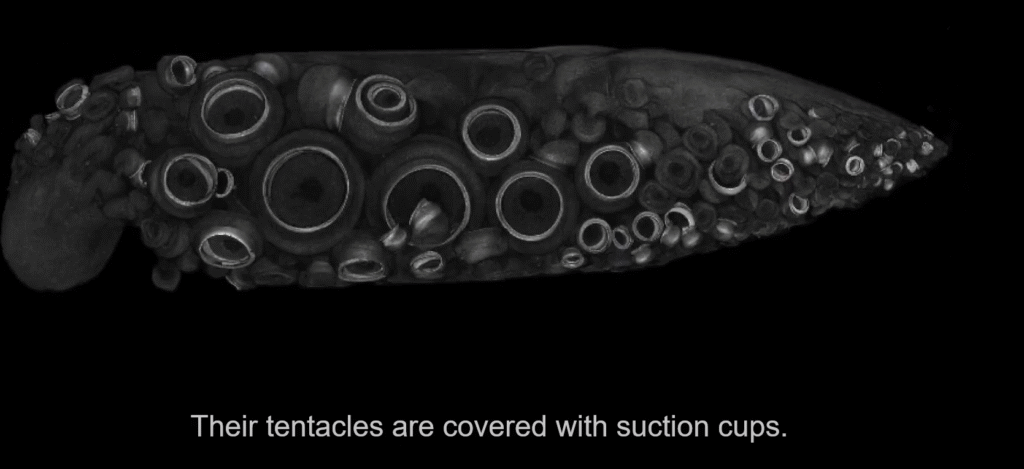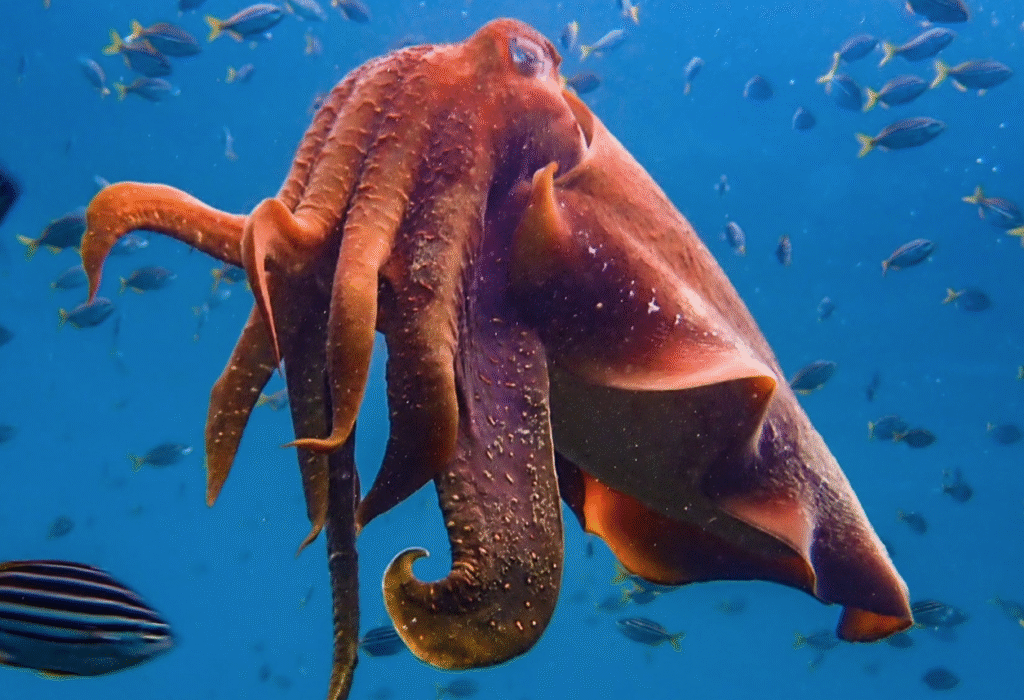When aliens came to Earth… they changed into cuttlefish

Think about octopuses and squid, then combine them – you get a cuttlefish. A cuttlefish has a pointy looking mantle like a squid and can change colors like an octopus. They have tentacles too! In a way, their eyes are a combination of the squid circle and the octopus rectangle: badda-boom, badda-bing: a W! I find it fascinating that cuttlefish are really slow, so they must hypnotize their prey by flashing different colors. I also find it really fascinating that they store very highly dangerous poison in their muscles. Cuttlefish are cephalopods, and a common factor between practically all cephalopods is that they have venom. We’ll get into more details later; for now, just focus on what is in front of you.

Cuttlefish are unique in a few different ways. Their eyes are shaped like Ws.

They have eight arms, and two tentacles. At the bottom of their tentacles they have suction cups like the ones at the bottom of young children’s bowls.

The suction cups help them wrangle their prey. Cuttlefish can normally be up to 15-25 cm in size (in inches, 6″-10″) which is as big as a guinea pig. The biggest kind of cuttlefish, the Sepia apama is huge, and can be up to 50 cm (in inches, 20) which is the length of a Pomeranian. Cuttlefish guts can collect algae and amino acids, especially during spring, and summer.

The cuttlefish diet includes many sea creatures, for example: crabs, shrimp, and fish. Cuttlefish also eat their own kind. I thought this was extremely rare, but it turns out that 1,500 species engage in this irrational behavior. They also have many predators other than themselves: dolphins, sharks, and seals. Cuttlefish usually live up to 1-2 years and are one of the smartest invertebrates in the world. If you compare a cuttlefish brain to its body, it would be huge.

Cuttlefish store poison in their muscles. The poison in their muscles is as murderous as the poison of the highly toxic blue ringed octopus. I hypothesize that the poison is there because one of the cuttlefish’s predators is a shark, and a shark can smell blood so it should be able to find the poison. I bet other predators can also smell the poison too. Cuttlefish have venom too. The poison in their muscles never comes out, so it’s classified as poison, but they also store venom in their beak that they inject into their prey. Since it comes out it’s venom. They inject venom out of their beaks (a scissor-like structure made of proteins and chitin) by biting to assassinate their prey.

Cuttlefish are colored flamboyantly as a warning that they are poisonous. This is called aposematism. Although the most vibrant, and colorful cuttlefish are the ones that most of the time are most poisonous, the dwarf, and the European cuttlefish are found to have a little bit of TTX (tetrodotoxin), which is the same poison that the vibrant cuttlefish have.

This reminds me that some butterflies are also aposematic. Did you know that the monarch butterfly is vibrant, but isn’t poisonous? It’s because it’s trying to mimic another butterfly that looks just like it, but is poisonous. This butterfly is called the viceroy butterfly.

Will you be poisoned if you eat a cuttlefish? Most of the time people don’t get affected by the cuttlefish toxins when they eat them. But there is a slight chance especially if it is a youngling, or has a high amount of toxins.
As mentioned above, cuttlefish are usually born with eight arms, and two extra tentacles; the extra tentacles are used to both wrangle prey and shield off predators. I bet it would be good at soccer because it would be good at offense and defense. If cuttlefish feel threatened they suck water into a part of their body called the mantle cavity to make themself bigger. The mantle cavity is shaped like a rocket so they can push themselves forward to go faster, while they steer with their fins.

Like the squid and octopus which are also in the nautilus family, the cuttlefish has an ink sac which can be used to flee predators that catch prey with their sense of sight. The cuttlefish can spray the ink in two different, but helpful ways. When the cuttlefish sees a predator it sprays the ink from behind, making a black misty cloud, and while the predator is trying to find the way out, the cuttlefish escapes. The other way is the cuttlefish sprays some ink covered in mucus that bubbles up into a cuttlefish dummy made out of ink. The ink sometimes blocks the predator’s sense of smell.

Cuttlefish cannot see color, but they can tell light from dark. If they see a color on the lighter side it appears to be a lightish grayish color. If it is a darker color then it appears to be a darkish blackish color. Imagine it as its eyes are like one of those old-timey cameras. In fact, a cuttlefish’s eyes are completely formed in the egg before they hatch. That also causes them to be able to see what is near while they’re still in the egg. If a cuttlefish sees some prey while they are still in their egg they remember it and try to hunt it later.
Even though cuttlefish can’t see color, they have the second most-developed eyes in the animal kingdom. Us humans make our eye lenses bigger, or smaller, but cuttlefish change the shape of their eyes based on the lighting. You’ve been waiting this entire time to figure out just WHY the eye is shaped like a W, right? Well, the W-shaped eye increases how much light comes in.

Cuttlefish blood is a blueish, greenish color, because their blood contains copper instead of iron which is what makes our blood red. Additionally, cuttlefish have three hearts like octopuses and squid. Two of them for both of their gills, and one for its whole body. Which I find crazy, just imagine having one heart for each side of our lungs then one left over for the rest of our body? Cuttlefish hearts have to pump blood faster, because copper holds less oxygen than iron does, which means that their hearts have to pump more oxygen.
The cuttlefish has an internal shell called the cuttlebone. This internal shell controls how much the cuttlefish floats; it also balances the cuttlefish. The cuttlebone has chambers that store gas, and water. By moving around the gas, and water, which sometimes takes hours, the cuttlebone helps the cuttlefish change its density, and controls its buoyancy. Cuttlefish can also move with the help of its fins, and mantle. The cuttlebone has a lot of calcium in it. Apparently it has so much calcium that some people catch cuttlefish, and they take the cuttlebone out, to sell to bird owners for food for their pet.

Overall I loved learning about the cuttlefish. Whether it’s their turquoise blood to their inc sac, every single fact was fascinating. I don’t think I’ve ever learned about a cooler animal, and I never thought I would say that because I’m an encyclopedia of animal facts.
Student Feedback from Lana Luu:
I thought your story about cuttlefish was really good! I liked how you put a combination of an octopus and squid because I can kind of envision it. I also thought it was creative how you said their eyes were like a W. One of the parts I think is the most interesting was when you said they can hypnotize their prey just by flashing colors because I think that’s cool. I also thought it was a good idea to add that they can make an ink dummy to trick predators because I never knew animals could make fake versions of themselves like that. It’s like they are playing a trick. I thought it was fascinating that their blood is blueish green because they have copper instead of iron like us. I didn’t even know animals could have different colored blood. In the text it states, “Cuttlefish blood is a blueish, greenish color, because their blood contains copper instead of iron which is what makes our blood red”. The part about them having three hearts was surprising because humans have one heart. I liked how you compared their sizes to animals like a guinea pig and a Pomeranian. “Cuttlefish can normally be up to 15-25 cm in size (in inches, 6″-10″) which is as big as a guinea pig,” and “the Sepia apama is huge, and can be up to 50 cm (in inches, 20) which is the length of a Pomeranian.” That made it easier for me to imagine how big the cuttlefish is. I really liked when you talked about aposematism and how bright colors could be a warning. The butterfly part was especially interesting because it’s not just ocean animals that do that. In conclusion, I think you did a great job! You have a lot of facts and you mixed in jokes and made it fun to read about cuttlefish. Now I know a lot about the cuttlefish and how interesting it is.
Student feedback from Isaac Zhang:
I was amazed by this essay. I really loved how you came across to the reader in a friendly tone, which really felt like it was inviting me to learn more about cuttlefish. Another thing I enjoyed about the essay was the amount of information. It wasn’t overwhelming or confusing but taught me a lot. For example, I had no idea that any animal could use hypnosis as a tool, let alone hypnotize by flashing colors on their body. I also never could have imagined that cuttlefish could have special bones that help to trap gases and keep the fish buoyant. Another part I really enjoyed about your essay was how you helped readers understand by relating information to something everyone is familiar with, like how you showed the concept of aposematism, “Did you know that the monarch butterfly is vibrant, but isn’t poisonous? It’s because it’s trying to mimic another butterfly that looks just like it, but is poisonous. This butterfly is called the viceroy butterfly”… by relating it to butterflies. Another example of this is when you helped readers visualize the length of a cuttlefish by comparing it to a dog, “The biggest kind of cuttlefish, the Sepia apama is huge, and can be up to 50 cm (in inches, 20) which is the length of a Pomeranian.” In conclusion, I think you did a great job with the pictures and the writing which elevated your writing. Your writing was not only informative but also entertaining, including many jokes, like your title, which works, especially as we witness the photographs, and the way you say, “badda-boom, badda-bing”! Overall a joy to read.
